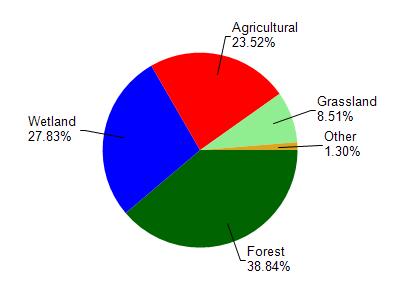Taylor
No
No
Yes
Fish and Aquatic Life
Overview
This 69 acre lake is located at the headwaters of Paradise Creek. The majority of Hulls Lake is quite shallow. Winterkills of the fishery have been a major lake management problem. The Hulls Lake Association operates a winter aeration system with the approval of the Department.
A self-help volunteer currently samples the lake for water quality information. Winter dissolved oxygen monitoring is conducted annually by the Department and kept on file at the Park Falls DNR office. A Lakes Planning Grant could fund the collection of such data (Ryan).
Date 1999
Author Aquatic Biologist
Historical Description
Hulls Lake is a soft water, drainage lake located at the headwaters of Paradise Creek. The estimated normal outlet flow is 3.5 cubic feet per second. Severe winterkills occur occasionally, and these tend to change the composition of the fish population. Prior to the winter of 1964-65, the lake contained northern pike, largemouth bass, crappies, pumpkinseeds, bluegills. rock bass, black bullheads, white suckers, golden shiners, and mud minnows. A survey with electro-fishing gear during June of 1965 revealed that only the latter four species of fish remained. Bluegills and largemouth bass were stocked in 1966 to improve the fishing. The lakeshore vegetation is approximately 50 percent upland hardwood and 50 percent tamarack-tag alder swamp. The littoral bottom material is made up of equal acres of gravel and muck and supports moderate plant growth. Furbearer use is significant. Migratory waterfowl use is small, although mallard and wood ducks use the lakeshore for nesting. There is a boat launching ramp at the town access site on the west shore. Private development consists of one resort and boat rental, and eight cottages.
Source: 1970, Surface Water Resources of Taylor County Hulls Lake, T32N, R1W, Section 29 Surface Acres = 66.8, Maximum Depth = 18 feet, M.P.A. = 21 ppm, Secchi Disk = 5 feet.
Date 1970
Author Aquatic Biologist
Impaired Waters
Hulls Lake (WBIC 1762700) was listed for total phosphorus in 2016. The 2018 assessments showed continued impairment by phosphorus; new total phosphorus sample data exceeded 2018 WisCALM listing thresholds for the Recreation use and Fish and Aquatic Life use. Chlorophyll data clearly exceeded the REC use threshold, but clearly met the FAL use threshold. Based on the most updated information, no change in the existing impaired waters listing was needed.
Date 2017
Author Ashley Beranek
Impaired Waters
Hulls Lake (WBIC 1762700) was assessed during the 2016 listing cycle; total phosphorus and chlorophyll sample data exceeded 2016 WisCALM listing thresholds for the Recreation use, but did not exceed Fish and Aquatic Life thresholds.
Date 2015
Author Aaron Larson
Condition
Wisconsin has over 84,000 miles of streams, 15,000 lakes and milllions of acres of wetlands. Assessing the condition of this vast amount of water is challenging. The state's water monitoring program uses a media-based, cross-program approach to analyze water condition. An updated monitoring strategy (2015-2020) is now available. Compliance with Clean Water Act fishable, swimmable standards are located in the Executive Summary of Water Condition in 2018. See also the 'monitoring and projects' tab.
Reports
Management Goals
Wisconsin's Water Quality Standards provide qualitative and quantitative goals for waters that are protective of Fishable, Swimmable conditions [Learn more]. Waters that do not meet water quality standards are considered impaired and restoration actions are planned and carried out until the water is once again fishable and swimmable
Management goals can include creation or implementation of a Total Maximum Daily Load analysis, a Nine Key Element Plan, or other restoration work, education and outreach and more. If specific recommendations exist for this water, they will be displayed below online.
Monitoring
Monitoring the condition of a river, stream, or lake includes gathering physical, chemical, biological, and habitat data. Comprehensive studies often gather all these parameters in great detail, while lighter assessment events will involve sampling physical, chemical and biological data such as macroinvertebrates. Aquatic macroinvertebrates and fish communities integrate watershed or catchment condition, providing great insight into overall ecosystem health. Chemical and habitat parameters tell researchers more about human induced problems including contaminated runoff, point source dischargers, or habitat issues that foster or limit the potential of aquatic communities to thrive in a given area. Wisconsin's Water Monitoring Strategy was recenty updated.
Grants and Management Projects
Monitoring Projects
| WBIC | Official Waterbody Name | Station ID | Station Name | Earliest Fieldwork Date | Latest Fieldwork Date | View Station | View Data |
|---|
| 1762700 | Hulls Lake | 10019374 | Hulls Lake -- Access | 6/27/2015 | 7/7/2015 | Map | Data |
| 1762700 | Hulls Lake | 10005847 | Hulls Lake | 8/8/2001 | 9/2/2016 | Map | Data |
| 1762700 | Hulls Lake | 613084 | Hulls Lake - Deep Hole | 8/1/1987 | 1/1/2015 | Map | Data |
|

Watershed Characteristics
Hulls Lake is located in the Trappers and Pine Creeks watershed which is 134.31 mi². Land use in the watershed is primarily forest (38.80%), wetland (27.80%) and a mix of agricultural (23.50%) and other uses (9.80%). This watershed has 181.16 stream miles, 550.88 lake acres and 15,489.14 wetland acres.
Nonpoint Source Characteristics
This watershed is ranked Low for runoff impacts on streams, Not Available for runoff impacts on lakes and Medium for runoff impacts on groundwater and therefore has an overall rank of Medium. This value can be used in ranking the watershed or individual waterbodies for grant funding under state and county programs.However, all waters are affected by diffuse pollutant sources regardless of initial water quality. Applications for specific runoff projects under state or county grant programs may be pursued. For more information, go to surface water program grants.